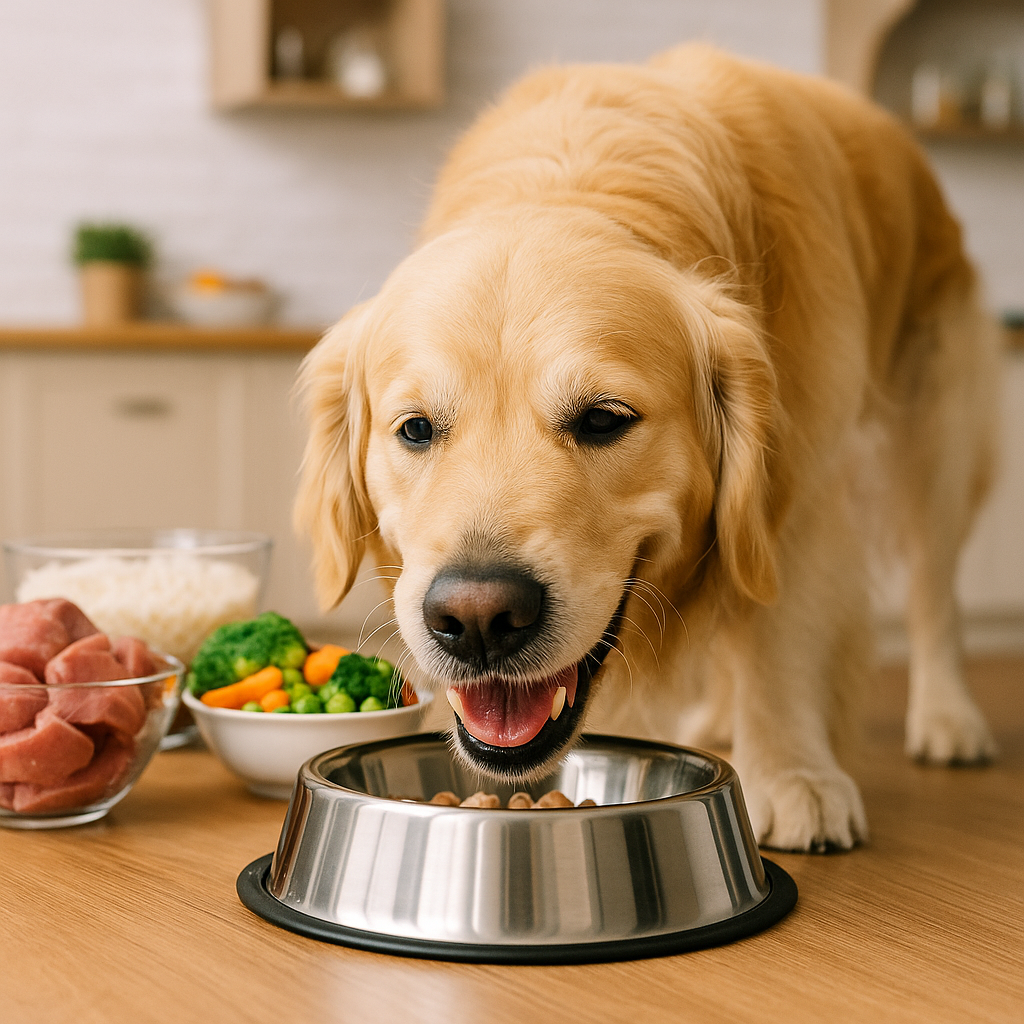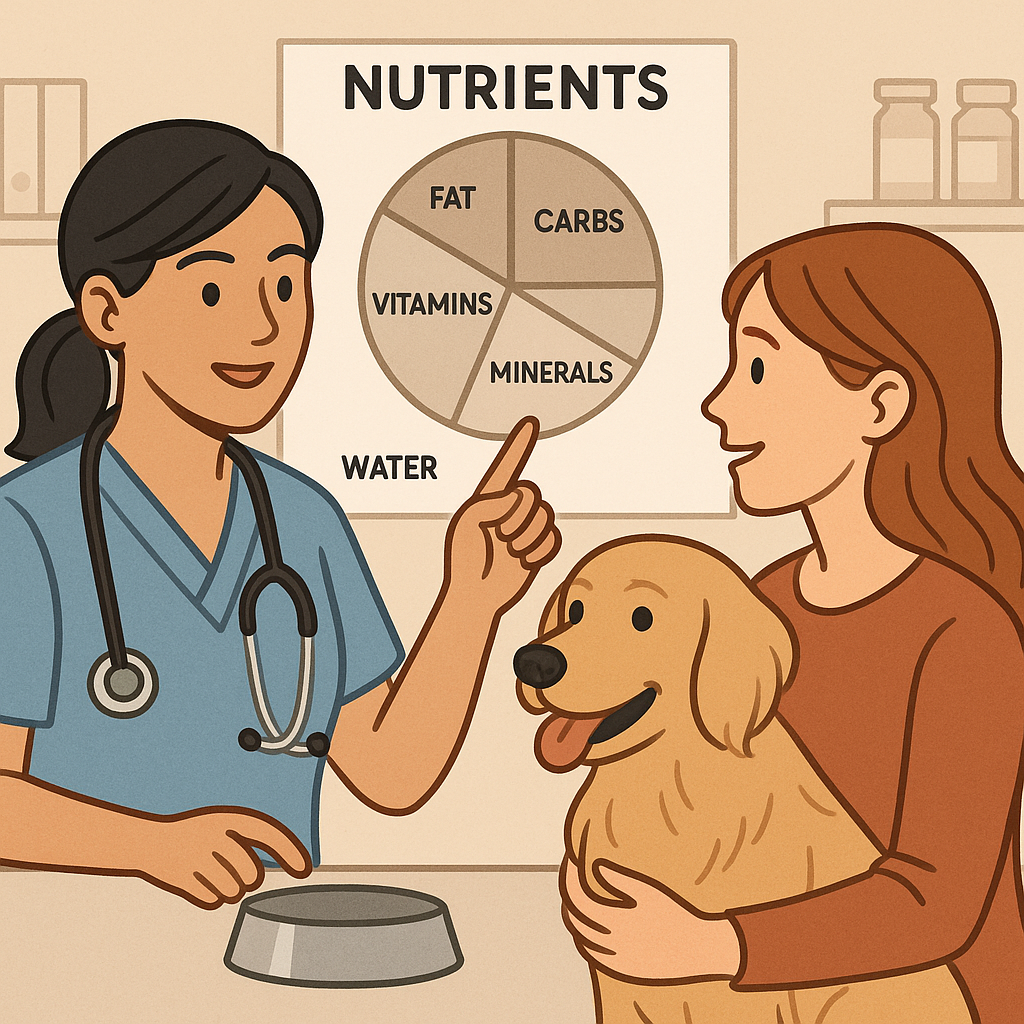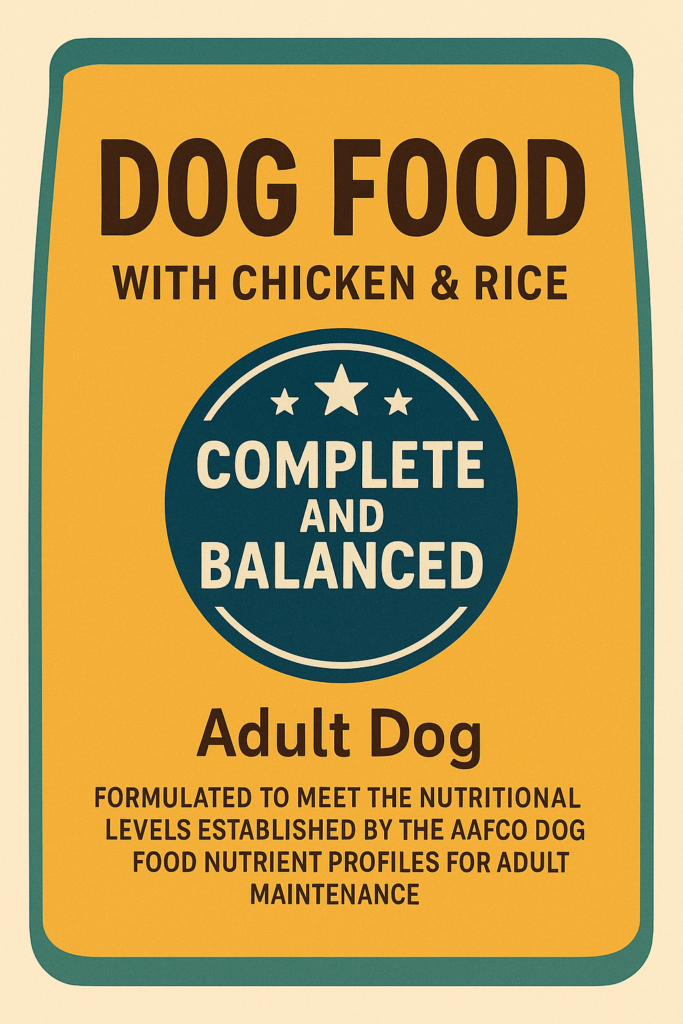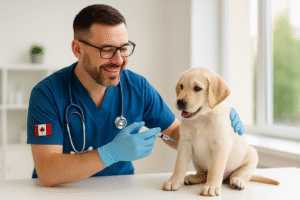Disclaimer: This article is for informational purposes only and does not replace professional veterinary advice. Always consult your veterinarian for personalized guidance on your dog’s nutrition and health.
Table of Contents
Introduction
Does your dog’s food bowl deliver everything they need to thrive—or just enough to get by? As a veterinarian, I’ve seen firsthand how the right diet can transform a dog’s coat, energy, and overall vitality. Whether you feed kibble, home-cooked meals, or something in between, understanding the importance of a balanced diet for dogs can help your furry friend live a longer, healthier life.
In this article, we’ll break down what a “complete and balanced” diet really means, why a balanced diet matters for dogs and which nutrients matter most, and how you can confidently feed your dog for lifelong wellness. From decoding pet food labels to vet-approved cooking tips, we’ve got you covered.
Key Takeaways
- A balanced diet for dogs means providing all essential nutrients—proteins, fats, carbs, vitamins, minerals, and water—in the right proportions.
- Nutrient needs change with age, size, and activity level. Puppies, adults, and seniors each have unique dietary requirements.
- Look for commercial dog foods labeled “complete and balanced” according to AAFCO standards. These are formulated to meet a dog’s full nutritional needs.
- Poor nutrition can lead to obesity, weak immunity, skin problems, and more, while a well-balanced diet supports energy, coat health, and disease prevention.
- Homemade meals can work—but only when planned with a veterinary nutritionist to avoid serious deficiencies or excesses.
- Always keep fresh water available, limit treats, and talk to your vet if you’re unsure about food quality or portion size.

What Is a Balanced Diet for Dogs?
Complete vs. Balanced: What Those Labels Mean
A truly balanced diet for dogs contains all the essential nutrients in the right ratios. When a commercial dog food says it’s “complete and balanced,” it means it meets or exceeds standards set by the Association of American Feed Control Officials (AAFCO) for a specific life stage—like puppyhood, adulthood, or senior years.
Look for a statement like:
“Formulated to meet the nutritional levels established by the AAFCO Dog Food Nutrient Profiles for maintenance of adult dogs.”
This label guarantees your dog is getting the nutrients they need daily—no need for extra supplements unless prescribed.
Better health: Reduces risk of diseases like obesity, diabetes, and heart problems
Why Balanced Diet Matters for dogs
Stronger immunity: Helps fight off infections and recover faster from illness
Healthy coat and skin: Fewer allergies, less itching, shinier coat
Improved digestion: Less bloating, firmer stools, fewer GI upsets
More energy: Balanced diet for dogs fuel active play and better behavior
Life Stage Nutrition: Puppies, Adults, Seniors
Feeding a food designed for your dog’s life stage matters:
- Puppies need more calories, protein, calcium, and phosphorus for rapid growth.
- Adults require nutrients to maintain muscle, coat, and overall health.
- Seniors may benefit from lower-calorie diets and joint-friendly additives like omega-3s.
Feeding puppy food to a sedentary adult or adult food to a growing pup can lead to nutritional imbalances or developmental issues.
Dogs Are Omnivores: Animal and Plant Ingredients
Dogs thrive on both animal and plant sources—they’re omnivores, not carnivores. A diet of just meat isn’t enough and can cause deficiencies in calcium, fiber, and certain vitamins. High-quality diets may include grains, vegetables, and fruits for fiber, antioxidants, and complex carbs, all contributing to a complete nutritional picture.

The 6 Essential Nutrients Every Dog Needs
A balanced diet for dogs must provide these six essential nutrient groups daily:
1. Protein
The body’s primary building block—protein supports muscle growth, tissue repair, immune health, and enzyme production. High-quality sources include:
- Chicken, beef, lamb, fish, eggs
- Legumes and certain grains (less complete)
Veterinary Tip: I often recommend diets with meat as a top ingredient. Dogs with skin issues or poor healing frequently improve once protein intake is corrected.
2. Fats (Especially Omega-3 & Omega-6)
Fats which is no doubt a balanced diet for dogs provide energy, support hormone function, and help the body absorb fat-soluble vitamins. Essential fatty acids keep the skin hydrated and the coat glossy.
Sources:
- Chicken fat, fish oil, flaxseed, sunflower oil
Too little fat = dry skin, dull coat; too much = obesity risk.
3. Carbohydrates & Fiber
Though not essential like proteins or fats, carbohydrates offer accessible energy. They also provide fiber for healthy digestion.
Good sources:
- Brown rice, barley, oats, sweet potatoes, beet pulp
Fiber helps prevent diarrhea and supports gut health.
4. Vitamins
Vitamins are critical for immune support, metabolism, and growth. Dogs need:
- Vitamins A, D, E, K, and B-complex
Commercial foods add these in proper amounts. Avoid over-supplementing—excesses can harm.
5. Minerals
Essential for bone health, nerve transmission, fluid balance, and more. Important ones:
- Calcium, phosphorus, zinc, iron, selenium, copper, potassium
Ratios (like calcium: phosphorus) must be correct—especially for puppies.
6. Water
Water is the most important nutrient. It supports every bodily function, from temperature regulation to toxin elimination.
Rule of thumb: Dogs need about 50–60 mL/kg of body weight per day. Always offer fresh, clean water.
Why Balanced Diet for Dogs Is So Important
Feeding your dog a complete and balanced diet does more than fill their belly—it fuels their whole body. Here’s how:
Coat, Skin, Energy, Immunity, Digestion
- Energy & Vitality: Balanced carbs and fats give dogs the stamina to play, walk, and stay alert without packing on weight.
- Healthy Skin & Shiny Coat: Omega fatty acids and proteins are key. A glossy coat often signals proper nutrition.
- Strong Muscles & Ideal Weight: Adequate protein supports lean muscle. Balanced calories help maintain a healthy body condition.
- Robust Immunity: Vitamins A, E, and C, along with zinc and selenium, help the body fend off illness.
- Better Digestion: Fiber supports gut health and stool quality. Nutrient balance reduces upset stomachs and food intolerances.

My Clinical Perspective
I once treated a young Labrador who came in with patchy fur, frequent infections, and low energy. His diet? A homemade mix of ground beef and rice—no supplements. After switching him to a veterinary-recommended, balanced diet, his coat regrew, infections resolved, and energy returned in weeks. The change was dramatic—and entirely food-driven.
What Can Go Wrong with Poor Nutrition?
Obesity: Too Much of a Good Thing
Overfeeding or offering calorie-dense foods can quickly lead to obesity—a major health issue. Excess weight puts stress on joints, increases the risk of diabetes, heart disease, and arthritis, and reduces quality of life. Even a few extra pounds can shorten your dog’s lifespan.
Canadian Context: In my Ottawa clinic, I often see overweight dogs who are simply being loved a little too much with treats. A body condition score check at each visit helps us catch this early and adjust diets before it leads to serious health problems.
Deficiencies: When Nutrients Are Missing
Imbalanced diets—especially poorly planned homemade meals—can lead to nutritional deficiencies. Common examples include:
- Calcium deficiency: Causes weak bones or fractures
- Zinc or vitamin A deficiency: Leads to poor coat, infections
- Iron deficiency: Can cause anemia and fatigue
- Protein deficiency: Results in muscle loss and poor healing
Even subtle imbalances, over time, can lead to chronic illness.
Long-Term Consequences
Prolonged poor nutrition can impair growth in puppies, weaken immunity, or contribute to organ damage. If a diet lacks even one critical nutrient for months, the effects may be irreversible. That’s why feeding a complete and balanced diet is so essential—every day.
Choosing the Right Commercial Dog Food

AAFCO Standards and Label Decoding
The easiest way to ensure balanced nutrition is by choosing a commercial dog food labeled “complete and balanced” per AAFCO standards. Look for statements like:
- “Complete and balanced for growth”
- “Complete and balanced for adult maintenance”
Avoid foods lacking this designation—they’re often treats or supplements, not suitable for full-time feeding.
Ingredients to Look For
Quality ingredients matter. Look for:
- A named animal protein (e.g., chicken, beef) as the first ingredient
- Balanced omega-3 and omega-6 fats
- Whole grains or vegetables as digestible carb sources
A diet doesn’t have to be grain-free to be good—whole grains like brown rice or barley are healthy carb options for most dogs.
Vet Insight: Don’t be fooled by boutique or “all-natural” labels. Stick with brands that employ board-certified veterinary nutritionists and publish digestibility data.
Special Diets: Breed Size, Activity, Health
Consider your dog’s individual needs:
- Large breed puppies need special calcium/phosphorus ratios
- Seniors may benefit from joint-support nutrients
- Working dogs often need higher-calorie, high-fat diets
When in doubt, your veterinarian can help you tailor your dog’s food choice to their age, breed, and lifestyle.
Home Cooking for Dogs: Do’s and Don’ts
Work with a Veterinary Nutritionist
If you’re preparing home-cooked meals, always consult a board-certified veterinary nutritionist. Many homemade dog food recipes online are deficient in essential nutrients, and even well-meaning owners can unintentionally cause harm.
Reliable services like BalanceIT or university-based vet nutrition consults (e.g., Tufts, UC Davis) can help build custom meal plans.
Avoid Common Pitfalls
Even the most nutritious-sounding home meal—like chicken, rice, and veggies—can be critically lacking in calcium, zinc, or omega-3s.
A proper recipe includes:
- A protein source (meat, eggs, tofu)
- A carb (rice, oats, potato)
- Vegetables (e.g., spinach, carrots)
- Calcium source (bone meal or supplement)
- A multivitamin or fortified blend for dogs
Never “eyeball” portions—follow exact measurements and prep steps.
Monitor Your Dog Closely
Watch for changes in:
- Weight (gain or loss)
- Stool consistency
- Coat and skin quality
- Energy levels
Your vet may recommend periodic bloodwork to confirm your homemade meals are meeting all of your dog’s needs. If done right, home feeding can be safe and rewarding—but it demands precision.
When to Consult Your Vet or Nutritionist
Nutrition plays a vital role in your dog’s health—don’t guess when expert help is available. Talk to your vet:
If You’re Unsure What or How Much to Feed
Vets can calculate your dog’s daily calorie needs and recommend portion sizes or specific products based on breed, weight, and activity.
When Your Dog Has a Medical Condition
From kidney disease to allergies, many conditions require special diets. Your vet may recommend a therapeutic food or refer you to a veterinary nutritionist for a custom plan.
Before Starting a Home or Raw Diet
Planning to cook meals or switch to raw feeding? Get professional guidance. These diets can work, but they’re not safe to “wing”.
If You Notice Health Issues
Frequent infections, flaky skin, poor growth, or digestive troubles may all point to dietary deficiencies or excesses. A vet exam can reveal what’s missing.
“Nutrition is one of the most powerful tools in preventive veterinary care.” – Tufts Petfoodology
5-Minute Home Checklist: Is Your Dog’s Diet Balanced?
Use this quick checklist to evaluate your dog’s daily nutrition at home:
✅ Does the dog food label say “Complete and Balanced” for their life stage?
✅ Is a named protein (like chicken or beef) in the top 3 ingredients?
✅ Are treats and extras <10% of total daily calories?
✅ Does your dog have consistent stools, good energy, and a shiny coat?
✅ Are you measuring portions using a kitchen scale or proper scoop, not guessing?
✅ Is your dog maintaining a healthy body condition—ribs easily felt but not seen?
If you answered “no” to any of these, it may be time to review your dog’s diet with your vet.
Typical Cost of Dog Nutrition in Canada
Here’s a breakdown of what Canadian pet owners can expect to spend on dog nutrition:
| Type of Dog Food | Approximate Monthly Cost (CAD) | Notes |
|---|---|---|
| Economy kibble (bulk brands) | $40–60 | Less digestible; may result in higher stool volume |
| Premium kibble (e.g. Royal Canin, Hill’s, Purina Pro Plan) | $70–120 | Better ingredient quality, nutrient balance |
| Veterinary therapeutic diets | $90–160 | Prescription-only; for specific health issues |
| Home-cooked (with supplements) | $100–180 | Depends on ingredients; requires a nutritionist plan |
| Raw diets (commercial) | $150–250 | More costly; controversial in vet circles |
Note: Costs vary by dog size. These estimates are for a medium-sized adult dog (~20–30 kg).
Prevention Tips for Lifelong Health
Good nutrition is preventive medicine. Here’s how to keep your dog thriving:
- Feed a balanced diet every day—don’t rely on treats or table food to “fill in the gaps.”
- Weigh your dog monthly and adjust portions to avoid slow weight gain.
- Transition food gradually over 5–7 days to prevent tummy upsets.
- Use treat calories wisely—small, low-cal options are best for training.
- Don’t skip vet checkups. Diet-related issues often show up during routine exams.
- Reassess food choice yearly, especially as your dog ages or activity level changes.
Preventing diet-related disease is far easier than treating it—start with the bowl.
FAQs
What does “complete and balanced” actually mean?
It means the dog food meets all essential nutrient requirements set by AAFCO for a specific life stage—such as growth or adult maintenance. These diets can be fed as the sole source of nutrition.
Can I feed my dog a vegetarian diet?
It’s possible, but tricky. Dogs are omnivores, and a vegetarian diet must be formulated by a veterinary nutritionist to avoid serious deficiencies in protein, taurine, and B vitamins.
How do I know if my dog food is good quality?
Check for:
- AAFCO “complete and balanced” claim
- Reputable brand that employs vet nutritionists
- Named protein high on the ingredient list
- Clear life stage labeling (puppy, adult, senior)
What signs show my dog isn’t getting the right nutrients?
Look out for dull coat, flaky skin, low energy, diarrhea, frequent infections, or poor growth in puppies. Always consult your vet if you notice changes.
Should I give my dog supplements?
Not unless your vet recommends it. Commercial foods already include balanced vitamins and minerals—extra supplements can do more harm than good.
Conclusion: Good Food = Good Life
A healthy dog starts with a balanced diet—one that delivers the right mix of protein, fats, carbs, vitamins, minerals, and water. Whether you’re choosing kibble, cooking at home, or blending both, the key is consistency, quality, and awareness of your dog’s unique needs.
The benefits? Fewer vet visits, better energy, shiny coats, healthy digestion, and a longer life with your best friend. From puppies to seniors, what you put in the bowl today shapes your dog’s tomorrow.
As a veterinarian, I’ve seen it time and time again: good nutrition changes lives. If you’re unsure where to start, ask your vet. They’re not just your dog’s doctor—they’re your partner in lifelong care.





Pingback: Healthy and Simple DIY Dog Food Recipes for All 3 Life Stages
Pingback: Puppy Deworming: Signs, Schedule & Safe Treatments 1605